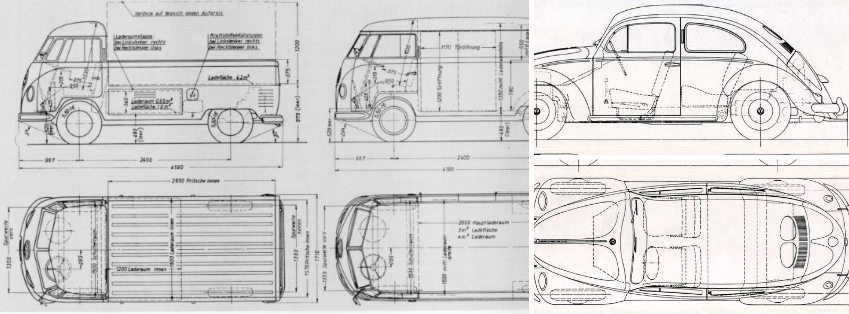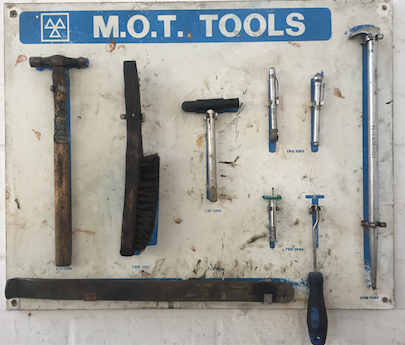Time for a CLASSIC VW MoT - Pass or Fail?
- About the MOT testing - History, Background
- Last update: 30 March 2016,
- Source(s): UK Gov website
The governing body in question is actually now called the Department for Transport, but we still know it as an MoT test, harkening back to
when the department was called the Ministry of Transport. Either way this department mandates periodic testing for vehicles of a certain age driven on
public roads. If your beloved classic Volkswagen is due for its first or next MOT Test, here are a few things that we get asked often enough to feel that the
topic is one that is worth sharing with everyone. By the way, do you think classic cars and vans should be exempt from MoT testing? Is enthusiasm a suitable substitute
for competence? After all, simply because someone is keen to work on their vehicle does not mean they know what they are doing. Send us your thoughts at #classicmot on our
facebook page.
Pre 1960? - Under Article 4(2) of the EU Directive 2009/40/EC, vehicles registered before 1960 are exempt from the yearly MoT test. Compulsory vehicle
testing was introduced in Great Britain in 1960 when the Motor Vehicles (Tests) Regulations 1960 came into operation. Initially the test - which became known as the 'MOT' test - was limited to braking,
steering and lighting equipment. New items and different standards have been introduced from time to time, including:
1968 - a tyre check;
1969 - a check for the presence of legally required seat belts;
1977 - checks of windscreen wipers and washers, direction indicators, stoplights, horns, exhaust system and
condition of the body structure and chassis together with a more detailed check on seat belts;
...until our current day. A test record is created on VOSA’s MOT database and a Test Certificate issued following successful completion of an examination.
Preparing for the MoT test - Hints & Tips
You are often allowed to watch the test but the mere thought of the annual MoT test usually sends
a shiver down the spine of the most hardened classic car owner as your pride and joy under-goes prodding and scrutiny
by the tester. It can be a very stressful occasion so it pays to do a bit of preparation before hand to help ensure that
you get a pass result. We are only able to give you a guide, and specifically aimed at Classic Volkswagens MoT testing, but the following information is
based on personal and acquired experiences so as to help you in advance of the big day.
The areas tested vary slightly depending on the age and model of the volkswagen, safari window vw campervans have
different requirements concerning windscreen washers for instance but we'll come to that, and chances are you'll only
ever fail emissions on an
older classic if you fill the workshop with plumes of smoke and set the water sprinklers off. It is also good to note that
if the vehicle is removed from the testing station for repair and returned for a retest before the end of the
10th working day following the day of the initial test then, provided the test station has not changed ownership,
only a partial re-examination is required.
One more thing to clear up. Can my vw fail for being lowered?: Yes; but let's clear this
up. If your vw is too low to be driven on to the test ramp, this failure to be tested is the actual problem resulting in the 'Fail'.
MoT testing: try to use a
garage that both offers a free MOT retest and allows you to take the car away and do the work yourself. Having said that,
here is a list of things to ensure prior to your classic car MoT test.
- Steering - works as intended, no
excessive play. All joints, mountings, track rod ends, split pins etc in good condition.
- The biggest failure cause: LIGHTS. Check all lights, indicators, semaphore indicators (if fitted), normal & main beam etc make sure they work. Should be bright and of equal intensity or funny enough its not a fail point as such if a pair are both equally dim but rectify this please.
Simply but tricky area, needing to slap the car to get the light going won't do. Check for earthing issues.
- There must be a secure petrol cover.
- Test out your wipers and washers, split wiper blades will result in a 'Fail'.
- Mirrors are a common fail point. There must be a right-hand door
mirror and one other, either inside or on the other door.
- Seats need to be firmly secured & make sure your horn works.
- Number plates are a part of the MoT test and must be clean,
undamaged and securely fixed.
- Tyres are a common fail item but are easy to check. The minimum
requirement is 1.6 mm of tread depth showing in the pattern all the way round the tyre and over
three-quarters of the width. No breaks, gaps or low spots are allowed. There must be no cuts, splits
or serious cracks in the tyres side-wall.
Do you specialise in testing classic VWs? - we want to hear from you!. For the benefit of
our readers we will be compiling a list of places, starting with those around the UK, where you can take
your Volkswagen to have your MoT done. We believe this is useful because far too many MoT centers are
not aware of how to apply the appropriate test techniques for classic cars, resulting in 'Fails' that should
really have been a 'Pass', had the examiner known what does and doesn't apply to classic vehicles.
If you already know about testing classic volkswagens specifically, and wish to have your company advertised
on our MoT test list, do get in touch with us. Our advertising rates are tailored
to suit all budgets. Get in touch with us today, you will be so glad you did. Just ask any of our current advertisers.
Had a MOT done on your Classic VW?




